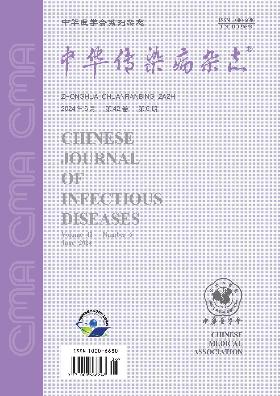Association between maternal syphilis treatment and adverse pregnancy outcomes
引用次数: 1
Abstract
Objective To examine the association between maternal syphilis treatmentand the adverse pregnancy outcomes. Methods Syphilis-infected pregnant women retrieved from Information System of Prevention Mother-to-child Transmission of Human Immunodeficiency Virus (HIV), Syphilis, and Hepatitis B Management in Hu′nan Province between January 2012 and December 2017 were retrospectively studied. Information of demographic characteristics, pregnancy history, and syphilis infection/treatment history among these syphilis-infected pregnant women were collected and analyzed. According to the anti-syphilis treatment situation during pregnancy, syphilis-infected pregnant women were divided into three groups: non-treatment group, non-standardized treatment group and standardized treatment group. The incidences of adverse pregnancy outcomes among the three groups were calculated. Multivariate logistic regression was used to control confounding factors and analyze the association between maternal syphilis treatment and the adverse pregnancy outcomes. The adjusted odds ratios (aOR) and 95% confidence interval (CI) were calculated. Results Among 9 059 syphilis-infected pregnant women, 13.9% (1 262), 31.3% (2 834), and 54.8% (4 963) were untreated, non-standardized treated and standardized treated patients, respectively. The incidences of total adverse pregnancy outcomes in the non-treatment, non-standardized treatment and standardized treatment groups were 25.5%(322), 20.8%(589), and 16.2%(806), respectively. The incidences of stillbirth in the three groups were 2.3%(29), 1.3%(38), and 0.6%(28), respectively; those of preterm birth were 12.6%(159), 10.5%(297), and 6.0%(299), respectively; those of low birth weight were 6.4%(81), 6.2%(175), and 3.3%(162), respectively; those of small for gestational age were 10.9%(138), 8.4%(237), and 8.0%(399), respectively; those of neonatal death were 1.3%(17), 1.0%(28) and 0.3%(15), respectively; those of neonatal asphyxia were 1.9%(24), 0.9%(25), and 0.9%(46), respectively; those of neonatal pneumonia were 0.6%(8), 0.9%(26), and 0.6%(32), respectively; those of birth defects were 2.8%(35), 1.3%(37), and 1.1%(57), respectively; those of neonatal congenital syphilis were 2.5%(31), 2.4%(69), and 0.8%(42), respectively. Compared with standardized treatment group, maternal syphilis without treatment was associated with increased risks of total adverse pregnancy outcomes (aOR=1.73), stillbirth (aOR=4.82), preterm birth (aOR=2.52), low birth weight (aOR=1.88), neonatal death (aOR=3.29), neonatal asphyxia (aOR=2.42) and birth defects (aOR=3.26) all P<0.01; maternal syphilis with non-standardized treatment was associated with increased risks of total adverse pregnancy outcomes (aOR=1.34), stillbirth (aOR=2.54), preterm birth (aOR=1.98), low birth weight (aOR=1.84), neonatal death (aOR=2.49) and neonatal congenital syphilis (aOR=1.70, P<0.05 or 0.01). Conclusions Maternal syphilis without treatment or with non-standardized treatment would increase the risks of adverse pregnancy outcomes. It is necessary to further strengthen the early screening and early treatment for syphilis-infected pregnant women, and improve the rate of standardized treatment to reduce the occurrence of adverse pregnancy outcomes. Key words: Syphilis; Pregnant women; Treatment; Adverse pregnancy outcomes孕产妇梅毒治疗与不良妊娠结局之间的关系
目的探讨孕产妇梅毒治疗与不良妊娠结局的关系。方法对2012年1月至2017年12月湖南省预防HIV、梅毒和乙肝母婴传播管理信息系统中感染梅毒的孕妇进行回顾性研究。收集并分析这些梅毒感染孕妇的人口统计学特征、妊娠史、梅毒感染/治疗史等信息。根据妊娠期抗梅毒治疗情况,将梅毒感染孕妇分为非治疗组、非规范化治疗组和规范化治疗组。计算三组不良妊娠结局发生率。采用多因素logistic回归控制混杂因素,分析孕产妇梅毒治疗与不良妊娠结局的相关性。计算校正优势比(aOR)和95%置信区间(CI)。结果9 059例梅毒感染孕妇中,未经治疗者占13.9%(1 262例),未规范治疗者占31.3%(2 834例),规范治疗者占54.8%(4 963例)。非治疗组、非规范化治疗组和规范化治疗组总不良妊娠结局发生率分别为25.5%(322例)、20.8%(589例)和16.2%(806例)。三组死产发生率分别为2.3%(29例)、1.3%(38例)和0.6%(28例);早产分别为12.6%(159例)、10.5%(297例)和6.0%(299例);低出生体重者分别为6.4%(81例)、6.2%(175例)和3.3%(162例);胎龄小的分别为10.9%(138例)、8.4%(237例)和8.0%(399例);新生儿死亡分别为1.3%(17例)、1.0%(28例)和0.3%(15例);新生儿窒息分别为1.9%(24例)、0.9%(25例)和0.9%(46例);新生儿肺炎分别为0.6%(8例)、0.9%(26例)和0.6%(32例);出生缺陷分别为2.8%(35例)、1.3%(37例)、1.1%(57例);新生儿先天性梅毒患病率分别为2.5%(31例)、2.4%(69例)和0.8%(42例)。与标准化治疗组相比,未经治疗的孕产妇梅毒总不良妊娠结局(aOR=1.73)、死胎(aOR=4.82)、早产(aOR=2.52)、低出生体重(aOR=1.88)、新生儿死亡(aOR=3.29)、新生儿窒息(aOR=2.42)、出生缺陷(aOR=3.26)的风险增加均P<0.01;非标准化治疗的孕产妇梅毒与总不良妊娠结局(aOR=1.34)、死胎(aOR=2.54)、早产(aOR=1.98)、低出生体重(aOR=1.84)、新生儿死亡(aOR=2.49)和新生儿先天性梅毒(aOR=1.70, P<0.05或0.01)相关。结论未经治疗或未经规范治疗的孕产妇梅毒会增加不良妊娠结局的发生风险。需要进一步加强对梅毒感染孕妇的早期筛查和早期治疗,提高规范化治疗率,减少不良妊娠结局的发生。关键词:梅毒;孕妇;治疗;不良妊娠结局
本文章由计算机程序翻译,如有差异,请以英文原文为准。
求助全文
约1分钟内获得全文
求助全文
来源期刊
自引率
0.00%
发文量
5280
期刊介绍:
The Chinese Journal of Infectious Diseases was founded in February 1983. It is an academic journal on infectious diseases supervised by the China Association for Science and Technology, sponsored by the Chinese Medical Association, and hosted by the Shanghai Medical Association. The journal targets infectious disease physicians as its main readers, taking into account physicians of other interdisciplinary disciplines, and timely reports on leading scientific research results and clinical diagnosis and treatment experience in the field of infectious diseases, as well as basic theoretical research that has a guiding role in the clinical practice of infectious diseases and is closely integrated with the actual clinical practice of infectious diseases. Columns include reviews (including editor-in-chief reviews), expert lectures, consensus and guidelines (including interpretations), monographs, short monographs, academic debates, epidemic news, international dynamics, case reports, reviews, lectures, meeting minutes, etc.

 求助内容:
求助内容: 应助结果提醒方式:
应助结果提醒方式:


